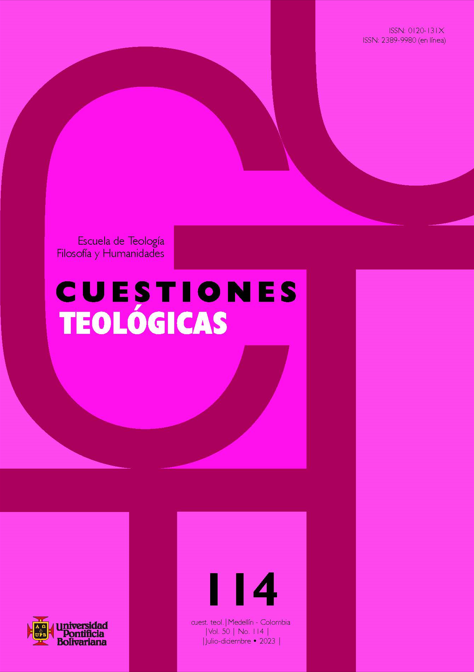Wedding metaphor in Scripture
Main Article Content
Abstract
Understanding the relationship between God and his people or between Christ and the Church in a conjugal way is a commonplace in the Judeo-Christian tradition. The frequency of this matrimonial imaginary does not silence the question about its origin or the fact that it is used so frequently to refer to a religious experience. This article addresses the complexity of the nuptial image and gets to the roots of its display in the Bible. To do this, after getting closer to understanding metaphors as a cognitive tool, we will explain the reasons that facilitated resorting to the marriage experience to understand the Alliance, as an essential element of the religious experience of Israel. We will also offer a quick overview of its deployment in Scripture by tracing the presence of the nuptial imagery beyond the passages in which it is evident.
References
Aguirre, R. (1994). La mesa compartida. Estudios del nt desde las ciencias sociales. Sal Terrae.
Borghino, A. (2005). La “Nuova Alleanza” in Is 54: análisis esegetico-teologica [Tesis doctoral, Universidad Gregoriana]. Calduch-
Benages, N. (2009). Jerusalem as Widow (Baruch 4:5-5:9). En H. Lichtenberger y U. Mittmann-Richert (Eds.), Biblical figures in Deuterocanonical and Cognate literature (dcly 2008) (pp. 147-164). Walter de Gruyter.
De Vaux, R. (1976). Instituciones del Antiguo Testamento. Herder.
Del Valle, C. (Ed.). (1997). La Misná. Sígueme.
Estévez, E. (2001). De ternuras y fidelidades. El Dios de entrañas compasivas. En I. Gómez-Acebo (Ed.), Así vemos a Dios (pp. 243-260). Desclée De Brouwer.
Fitzgerald, A. (1972). The mythological background for the presentation of Jerusalem as a queen and false worship as adultery in the OT. The Catholic Biblical Quarterly, 34(4), pp. 403-416.
Galambush, J. (1992). Jerusalem in the Book of Ezekiel. The city as Yahweh’s wife. Scholars Press.
García, M. (2020). Metáfora matrimonial en los profetas. Algunas cuestiones de género. En I. Fischer y J. Claassens (Eds.), Profecía (La Biblia y las mujeres 2) (pp. 219-228). Editorial Verbo Divino, Estella.
Giblet, J. y Grelot, P. (1978). Alianza. En X. Léon-Dufour, Vocabulario de teología bíblica (pp. 59-66). Herder.
Hugenberger, P. (1994). Marriage as a covenant. A study of biblical law and ethics goberning marriage developed from the perspective of Malachi [Tesis doctoral, Gloucestershire College]. https://eprints.glos.ac.uk/3339/1/292355.pdf.
Infante, L. (1984). L’Amico dello Sposo. Figura del ministero di Giovanni Battista nel vangelo di Giovanni. Pontificia Universitas Gregoriana.
Jacobs, G. (2022). Augustine of Hippo: Advocate of Scriptural Metaphor. Cuestiones Teológicas, 49(112), pp. 1-21.
Jeremias, J. (1980). Jerusalén en tiempos de Jesús. Estudio económico y social del mundo del Nuevo Testamento. Ediciones Cristiandad.
Kalluveettil, P. (1982). Declaration and Covenant. Biblical Institute Press.
Lakoff, G. y Johnson, M. (2001). Metáforas de la vida cotidiana. Cátedra.
Lewy, J. (1994). The old west semitic Sun-God ḥammu. Hebrew Union College Annual, 18(1944), pp. 429-488.
Luzárraga, J. (2005). Cantar de los cantares. Sendas del amor. Editorial Verbo Divino, Estella.
Maier, C. M. (2020). Hija de Sion y ramera Babilonia. Sobre la personificación femenina de ciudades y países en los profetas. En I. Fischer y J. Claassens (Eds.), Profecía (La Biblia y las mujeres 2) (pp. 203-218). Editorial Verbo Divino, Estella.
McCarthy, D. (1963). Treaty and Covenant. A study in form in the Ancient Oriental documents and in the Old Testament. Biblical Institute Press.
Morla, V. (2004). Poemas de amor y de deseo. Cantar de los Cantares. Editorial Verbo Divino, Estella.
Nubiola, J. (2000). El valor cognitivo de las metáforas. En P. Pérez-Ilzarbe y R. Lázaro (Eds.), Verdad, bien y belleza. Cuando los filósofos hablan de los valores (pp. 73-84). Universidad de Navarra.
Popko, L. (2015). Marriage metaphor and feminine imagery in Jer 2:1-4:2. A diachronic study based on the mt and lxx. Gabalda; Pendé.
Ricoeur, P. (2018). La metáfora nupcial. En P. Ricoeur y A. la Cocque, Pensar la Biblia: estudios exegéticos y hermenéuticos (pp. 275-311). Docencia.
Rostom, S. (2005). Lamentos neosumerios por ciudades destruidas. Continuidad de un rito y un género del período protodinástico hasta el período seléucida. Antiguo Oriente, (3), pp. 105-118.
Sánchez, L. (2019). Gesù, il Messia Sposo. La testimonianza dei Sinottici. En L. Pedroli (Ed.), L’Analogia nuziale nella scrittura. Saggi in onore di luis Alonso Schökel (pp. 67-91). Gregorian; Biblical Press.
Schökel, L. A. (1978). Las sandalias del Mesías esposo: símbolos del Antiguo Testamento como lenguaje del Nuevo Testamento. Cuadernos de Teología, (5), pp. 198-210.
Schökel, L. A. (1997). Símbolos matrimoniales en la Biblia. Editorial Verbo Divino, Estella.
Sicre, J. L. (2011). Introducción al profetismo bíblico. Editorial Verbo Divino, Estella.
Sohn, S.-T. (1999). I will be your god and you will be my people: The origin and background of the covenant formula. En R. Chazan, W. Hallo y L. H. Schiffman (Eds.), Ki Baruch Hu. Anciente near eastern, biblical, and udaic studies in honor of Baruch A. Levine (pp. 355-372). Eisenbrauns.
Tosato, A. (2001). Il matrimonio israelitico: una teoría generale. Nuova prefazione, presentazione e bibliografia. Editrice Pontificio Istituto Biblico.
Ubieta, J. A. (Dir.). (1999). Nueva Biblia de Jerusalén. Desclée De Brouwer.
Vásquez, J. F. (2009). El banquete de Doña Sabiduría en Prov 9,1-6. Cuestiones Teológicas, 36(86), pp. 407-433.
Verderame, L. (2010). La imagen de la ciudad en la literatura sumeria. Rivista degli Studi Orientali, 83(2010), pp. 23-48.
Villeneuve, A. (2016). Nuptial symbolism in second temple writings, the New Testament and rabbinic literature. Divine marriage at key moments of salvation history. Brill Academic Pub.
Weems, R. J. (1997). Amor maltratado. Matrimonio, sexo y violencia en los profetas hebreos. Desclée De Brouwer.
Wolff, H. (2017). Antropología del Antiguo Testamento. Sígueme.






